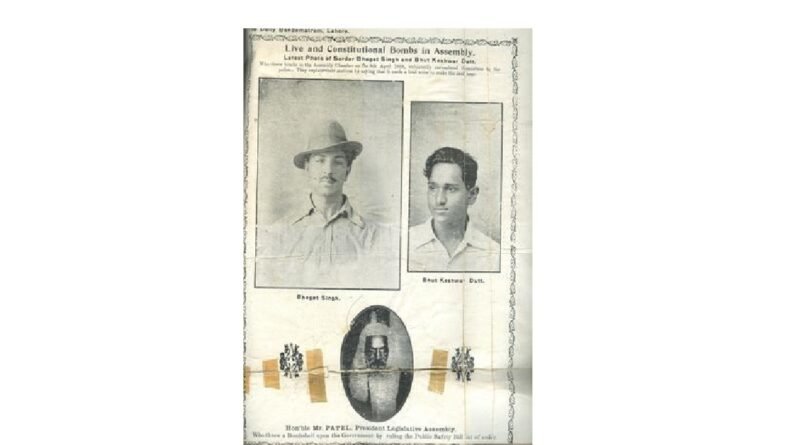Rare documents on Bhagat Singh’s trial and life in jail
Digitalised records with the Supreme Court reveal some inspiring facets of the revolutionary. Bhagat Singh and B.K. Dutt offered themselves for arrest after throwing harmless bombs in the Central Assembly to ‘make the deaf hear.’ Their case drew worldwide attention.
When the Supreme Court of India established a museum to display landmarks in the history of India’s judicial system, it also put on display records of some historic trials. The first exhibition that was organised was the ‘Trial of Bhagat Singh.’ It was opened on September 28, 2007, on the occasion of the birth centenary celebrations of one of the most significant among martyrs and popular heroes. Noorul Hooda, Curator of the Museum, and Rajmani Srivastava of the National Archives worked to collect documents, items like bomb shell remains, pictures and publications. Not all of what was collected could be displayed in the exhibition. In 2008, the Supreme Court digitalised the exhibits. Some of Bhagat Singh’s rare writings thus came to light for the first time since he was executed on March 23, 1931 at the Lahore Central Jail along with Rajguru and Sukhdev. How the three young patriots were put to judicial murder, is brought out by the eminent legal scholar, A.G. Noorani, in his book, The Trial of Bhagat Singh — Politics of Justice .
The most significant part of Bhagat Singh’s life is that spent in jail since his arrest on April 8, 1929 from the Central Assembly in Delhi, where he and B.K. Dutt offered themselves to be arrested after throwing harmless bombs in the Assembly to ‘make the deaf hear.’ They faced two trials. The first was in the Delhi bomb case. It started on May 7, 1929 in Delhi and was committed to the Sessions Judge, on charges under Section 307 of the Indian Penal Code and the Explosives Act. That trial started in June. Bhagat Singh and Dutt made a historic statement on June 6. Dutt was represented by the nationalist counsel Asaf Ali. Bhagat Singh fought his own case with the help of a legal adviser.
On June 12, in less than a week, both were convicted and transported for life. From the June 6 statement to his last letter to his comrades written on March 22, 1931, a day before his execution, Bhagat Singh read and wrote so much: one can only marvel at the explosion of talent at the age of 21 years-plus. He wrote letters to family members and friends, jail and court officials, and penned major articles including Why I am an Atheist , Letter to Young Political Workers , and Jail Notebook .
On June 14, after the conviction, Bhagat Singh was transferred to Mianwali and Dutt to the Lahore jail. That was the start of a chain of struggles throughout the period they were in jail. It began with a hunger strike from June 15 by both Bhagat Singh and Dutt, demanding the status of political prisoners. Bhagat Singh was also shifted to Lahore jail after some time. He and Dutt were kept away from the other accused in the Lahore conspiracy case, such as Sukhdev. The trial in that case, related to the murder of Saunders, began on July 10, 1929. Bhagat Singh, who was on hunger strike since June 15 along with Dutt, was brought to the court on a stretcher. The other accused in the case came to know about this hunger strike on that day, and almost all of them joined the strike.
This historic hunger strike by Bhagat Singh and his comrades resulted in the martyrdom of Jitender Das on September 13, 1929. Bhagat Singh and the other comrades ended their hunger strike on September 2 after receiving assurances from a Congress party team and British officials on the acceptance of their demands, but they resumed it on September 4 as the British officials went back on their word. It finally ended on October 4 after 112 days, though the status of “political prisoner” was still not given; some other demands were acceded to.
During the Lahore conspiracy case trial conducted by Special Magistrate Rai Sahib Pandit Kishan Chand, an incident occurred on October 21, 1929. Provoked by an approver named Jai Gopal, Prem Dutt, the youngest among the accused persons, threw a slipper at him. Despite the other accused dissociating themselves from the act, the magistrate ordered the handcuffing of all of them. Bhagat Singh, Shiv Verma, B.K. Dutt, Bejoy Kumar Sinha, Ajoy Ghosh, Prem Dutt and others were beaten after they refused to be handcuffed. They were treated brutally inside the jail and at the court gate in front of the magistrate. Ajoy Ghosh and Shiv Verma fell unconscious following the police brutality. Bhagat Singh was targeted by a British officer by name Roberts.
The details of the brutalities were recorded by Bejoy Kumar Sinha. In February 1930, Bhagat Singh resumed his hunger strike for 15 days, as the British officials did not fulfil the promises they had made earlier with respect to demands.
Meanwhile, the fame of revolutionaries, arising from their hunger strikes and court statements, soared, while the image of the British was at its lowest ebb. The case drew attention the world over. While dismissing appeals from Bhagat Singh and Dutt against the Delhi bomb case judgment, the Punjab High Court in Lahore acknowledged Bhagat Singh to be a ‘Sincere Revolutionary.’
The British colonial regime led by Viceroy Irwin took the unprecedented step of issuing the Lahore conspiracy case ordinance on May 1, 1930. Under this, the proceedings that were being conducted by a Special Magistrate in Lahore were transferred to a three-judge Special Tribunal established to complete them within a fixed period. The Tribunal’s judgment was not to be challenged in the superior courts; only the Privy Council could hear any appeal. This ordinance was never approved by the Central Assembly or the British Parliament, and it lapsed later without any legal or constitutional sanctity. Its only purpose was to hang Bhagat Singh in the shortest possible time. That judgment sentencing Bhagat Singh, Sukhdev and Rajguru to the gallows was delivered on October 7, 1930.
The Tribunal began its proceedings on May 5, 1930. The accused in the Lahore conspiracy case refused to attend the proceedings after May 12. On that day they raised slogans and sung revolutionary songs. Brutalities were repeated on them, as in October 1929, in front of the Special Magistrate. This time Ajoy Ghosh, Kundan Lal and Prem Dutt fell unconscious. The accused remained absent during the whole proceedings and remained unrepresented by counsel. Advocates engaged to defend them were insulted by the Tribunal. Subsequently, the accused themselves directed them not to defend them in their absence. These details are in A.G. Noorani’s book, The Trial of Bhagat Singh .
What remained out of view all these years were the many letters that Bhagat Singh wrote and the petitions he sent to either the jail authorities or to the Special Tribunal or to the Punjab High Court, during the period 1929-1930. In these letters and petitions, Bhagat Singh sought to expose the British colonial regime’s determined efforts to get him hanged by denying the accused any defence during the trial. Even though the accused were choosing not to be present in the court, they were participating in the legal proceedings through counsel. The Tribunal refused the revolutionaries’ counsel, Amolak Ram Kapoor, permission to cross-examine 457 prosecution witnesses and allowed the cross-examination of only five approvers. This was a farce.
The letters reveal another hunger strike by Bhagat Singh from July 28, 1930, on which he himself informed the High Court it was against the jail rules. He was joined in the hunger strike by Kundan Lal, Prem Dutt Verma, Sukhdev and Bejoy Kumar Sinha. This hunger strike continued till at least August 22. With this, the total period of hunger strikes observed during his nearly two-year incarceration becomes about five months. Probably this is more than the total period of Mahatma Gandhi’s hunger strikes during his prolonged political career starting from South Africa.
When the court finally allowed interviews as sought by Bhagat Singh to prepare his defence, and when he asked for an adjournment of the case, the court closed the proceedings without giving any chance to defence counsel to cross-examine prosecution witnesses or present defence witnesses. Then it reserved judgment, which was delivered on October 7, 1930.
More such documents might emerge. The compilation of the complete proceedings of the Delhi Assembly bomb case and the Special Magistrate Court’s proceedings could bring more facts to light. The Punjab Archives in Lahore has 135 files of the Bhagat Singh case. These are not accessible even to Pakistani scholars; Kuldip Nayar is now trying to get access to them. In 2006, at the time of the 75th anniversary of the martyrdom of Bhagat Singh, Rajguru and Sukhdev, the Acting Chief Justice of the Pakistan Supreme Court, Rana Bhagwan Dass, handed over to the Punjab and Haryana High Court in Chandigarh four volumes of exhibits of the Lahore conspiracy case. These included some new documents.
While the source of the documents in the Supreme Court records is not clearly mentioned, undoubtedly these are part of the trial proceedings at both levels. The letters, self-explanatory in the context of the freedom struggle, show the amazing command Bhagat Singh had over the English language, apart from Urdu, Hindi and Punjabi, his knowledge of legal terminology and his beautiful handwriting. In the book, Gandhi and Bhagat Singh , historian V.N. Dutta expressed doubts about Bhagat Singh’s command over English as he was an under-graduate. He sought to ascribe the language to Jawaharlal Nehru or Asaf Ali. For legal professionals, scholars and students, the letters present a wonderful experience of how Bhagat Singh had such maturity in complex matters of legal defence.
But Bhagat Singh’s very talent and competence scared the British colonial regime and it became even more determined to get rid of him.
The Supreme Court’s digitalised records include nearly 20 written Bhagat Singh documents. Some of these, such as the June 6, 1929 statement, ‘Ideal of Indian Revolution,’ have been published. Only 12 letters or petitions remain unpublished. This writer acknowledges the permission granted by the Supreme Court to do so. Ten of the documents are in complete form. Only the first page remains of two letters/documents, one relating to the October 21, 1929 incident in court and another petition from early-1930; the second and likely final page in these two are not in the digital records. Also available now is a photograph of Bhagat Singh and Dutt, published in ‘Bande Matram’, Lahore (on April 12, 1929) and Hindustan Times (April 18, 1929). This was taken by photographer Sham Lal of Kashmere Gate in Delhi on April 4, 1929 and sent to newspapers for publication by Bhagat Singh’s comrades. The writer is grateful to the National Archives, New Delhi, for providing the rare newspaper photographs.
[Chaman Lal, the editor of the Bhagat Singh Documents (Hindi: Publications Division) and the Jail Notebook and Other Writings (LeftWord), is a Professor at Jawaharlal Nehru University, now on deputation to The University of the West Indies, Trinidad &Tobago, as Visiting Professor.]
Source:




